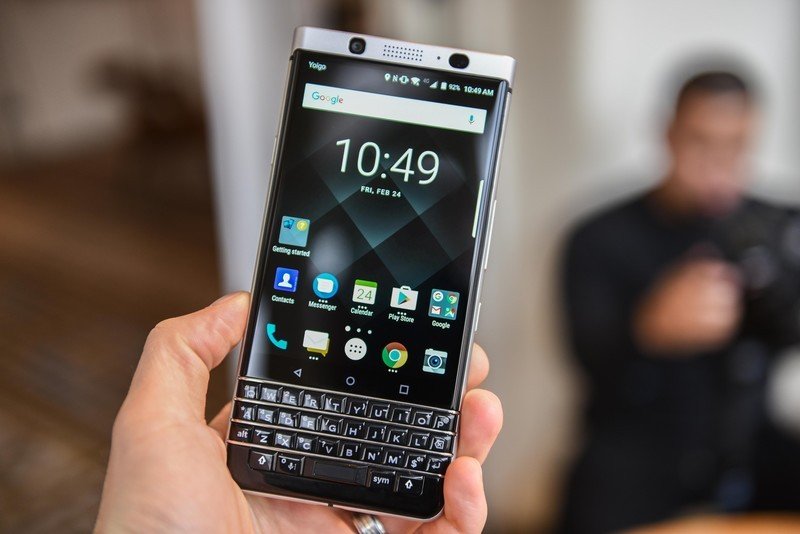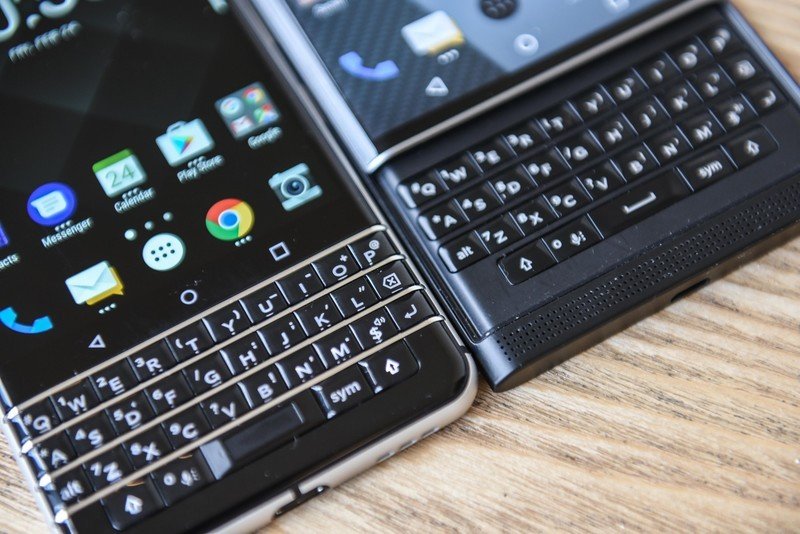BlackBerry KEYone hands-on: Your dad's favorite Android phone

The BlackBerry 'Mercury' isn't new — you saw it at CES — but the company behind the new phone, BlackBerry Mobile, has been trickle-announcing the hardware QWERTY flagship, teasing it to hardcore CrackBerry addicts who came of age tapping away on Bolds and Curves.
But this is a new BlackBerry — the phone itself is made by TCL, under the eponymous Waterloo company's brand — and the first in a series of devices set to be released this year, next year, and if successful, well beyond. This is the BlackBerry KEYone.
Now that we know more about the phone, I'm happy to report that it's actually quite nice. The aluminum frame is solid and the design is anything but pedestrian, with overtly curved sides meeting a flat-top frame and exposed antenna lines. There's an old-school industrial feel to the whole thing that I really dig — the dual tones of black and silver work really well here, harkening back to some BlackBerrys of the past while updating the look for 2017.
This is a great phone, unless you use a lot of landscape apps.
In fact, if you stare at the KEYone long enough, you begin to see its direct influences bleed through: this is a BlackBerry Passport Silver Edition squeezed and elongated, melded with the keyboard of the BlackBerry Classic. Of course, both those phones ran BlackBerry 10, and had square displays, precluding those form factors from working properly with Android. (In fact, BlackBerry was reportedly working on turning the Passport into an Android handset, but could never optimize the OS at the time, Lollipop, for its 1:1 aspect ratio.)
So now we're in 2017, with a brand new company, TCL Communication, overseeing the design and manufacturing of the largely-forgotten BlackBerry handset legacy, and after two nondescript metal-and-glass all-touch devices, BlackBerry is once again embracing its strangeness, its apartness, with the KEYone.
The spec sheet
| Category | KEYone |
|---|---|
| Operating System | Android 7.1.1 Nougat |
| Display | 4.5-inch, 1620x1080 (434 ppi)IPS LCD |
| Processor | Qualcomm Snapdragon 625Octa-core 2.00GHzAdreno 506 GPU |
| RAM | 3GB |
| Storage | 32GB |
| Expandable | microSD up to 2TB |
| Rear Camera | 12MP f/2.0, PDAF1.55-micron pixelsdual-tone LED flashHDR, 4K, 30fps |
| Front Camera | 8MP f/2.21.12-micron pixelsSelfie flash1080p/30 video |
| Battery | 3505 mAhnon-removable |
| Charging | Quick Charge 3.0USB-C |
| Water resistance | No |
| Security | DTEK security suiteFIPS 140-2 Full Disk EncryptionAndroid For Work, Google Play for Work |
| Connectivity | Wi-Fi 802.11ac, 5GHz, Bluetooth 4.2 LE, NFCGPS, GLONASS |
| Network (NA GSM) | LTE Band 1/2/3/4/5/7/8/12/13/17/19/20/28/29/30TD-LTE Band 38/39/40/41 |
| Network (NA CDMA) | LTE Band 1/2/3/4/5/7/12/13/20/25/26/28/29/30TD-LTE Band 41CDMA BC 0/1/10 |
| Network (EMEA) | LTE Band 1/2/3/4/5/7/8/13/17/20/28TD-LTE Band 38,40 |
| Dimensions | 149.1 x 72.39 x 9.4 mm |
| Weight | 180 g |

The core of the issue
Aside from the name, the one major part of the story missing from the intiial announcement back at CES was the spec sheet. While much had been surmised based on leaks, we now have context for exactly the market at which BlackBerry Mobile is aiming with this phone: workaholics. This is a phone positioned squarely for people in government agencies, healthcare, finance — bureaucrats and weekenders, alike — just like the good old days. Steve Cistulli, BlackBerry Mobile's GM, told me that every spec, including the Snapdragon 625, was chosen with one goal in mind: to prolong battery life.
I'm happy to say that the keyboard feels like a BlackBerry in the ways that count.
That is fueled by the non-removable 3505mAh battery, the largest ever found in a BlackBerry device. While we haven't used the KEYone for more than a few hours, I can safely say, based on the chip's impressive legacy inside devices like the Moto Z Play (which has a similar battery size), this thing will last well over a day, and perhaps close to two.
Be an expert in 5 minutes
Get the latest news from Android Central, your trusted companion in the world of Android
But that's all well and good — phones with big batteries abound. What's it like to actually use this thing, to straddle a permanent keyboard with a touchscreen interface that has, over the past few years, weened itself off any input method that isn't a finger (or, I guess, a stylus)?

The KEYboard
First, this is probably not the last phone from BlackBerry Mobile with an exposed QWERTY keyboard. You can tell from the name. The form factor may not be common in the Android space, but there is a small, loyal group of folks that have been clamoring for this exact device since the early part of this decade.
The whole experience lives and dies by the keyboard; if it didn't properly translate over to the brand's new overlord, the whole thing would be for nought, big battery and all. I'm happy to say that this feels like a BlackBerry in most ways. The contours you're used to from previous Bolds and Classics are gone, but that's on purpose: they reportedly got in the way of gesture navigation, which is a key part of the KEYone experience.

But other than that minor change, this is nearly the same keyboard you're used to from the Classic. It's clickly and responsive, with excellent travel — for more than the shallow, disappointing Priv — with keys of correct proportion for my fat thumbs.
BlackBerry KEYone vs. BlackBerry Priv
And while it took me, my joints, and my brain to re-form an alliance with the notion of pushing on physical keys over the smooth glass of a touchscreen, having done it for years it felt like coming home. But it's sort of like that childhood bedroom that hasn't changed in over 20 years; it's nostalgic and, at first, cozy, but after a while I get the impression it will feel suffocating and limiting.
If you stare at the phone long enough, you see that it looks like the love child of BlackBerry Passport Silver Edition and a BlackBerry Classic.
BlackBerry Mobile has augmented this keyboard with a few neat tricks, though none particularly innovative. As with with the Priv, the keyboard doubles as a trackpad for navigating between supported UI elements — swiping down a webpage, for instance, or flipping between photos — as well as 52 distinctive shortcut buttons that, either tapped or held, can launch apps or app shortcuts (though not, as I noted, the equivalent of the Pixel Launcher's app shortcuts, which appear to be kept separate).

One thing that was emphasized again and again about the KEYone is its one hand-friendliness, which it is. My human-sized thumb could reach the opposite end of the keyboard to peck out a response while holding a coffee (I tried it; it was good coffee!), aided by BlackBerry's always-excellent gesture-based suggestion engine.
Though it's not possible to use an on-screen keyboard with the KEYone (for obvious reasons), while typing a short row of three suggested words appear above the screen, easily chosen by swiping up in one of the three delineated sections of the keyboard.
And then there's the fingerprint sensor built into the spacebar. This is, really, the substantive differentiator from previous keyboards, and it's, well, great. While it's not the first BlackBerry with said feature — that debuted on the back of the DTEK60 — it's certainly the best implementation to date, and it saves time.

A camera to remember
While I didn't get a chance to sample too many of the KEYone's photos, I know this: the sensor, Sony's IMX378, is the same excellent one inside the Pixel, and while the phone lacks optical image stabilization, I was impressed by the results I saw. BlackBerry's done some spit-shining to the overall interface, too, including the addition of a very decent Pro mode, which should make it easier to get those low-light photos that we loved on the Pixel.
But simply putting a quality sensor inside a phone isn't a recipe for success — see practically every Sony phone released in the past four years — so it remains to be seen whether BlackBerry Mobile has managed to eke a win, but the IMX378 alone is a good start.

BlackBerry legacy
BlackBerry Mobile may a subbrand of another company, but the software here — Android 7.1.1 Nougat — is made by BB proper. The two organizations are working closely on the software, with the Canadian firm issuing updates and signing final builds to ensure that security is maintained throughout the process. That part — that the software is signed in North America — was emphasized, too, perhaps as pretense to a carrot of sorts, to convince U.S. government agencies that the KEYone is the right tool for the job.
You also get all the improvements you'd expect in Nougat — which hasn't been made available for the Priv, or any Android-based BlackBerry just yet — including multi window, display scaling, and improved notifications. These are core features one would expect on any modern Android phone, and they translate here to great success, largely because BlackBerry doesn't spend much effort skinning the phone. Even the launcher is as barebones as manufacturer launchers get. Alas, though: no Google Assistant (but yay for display scaling and monthly security updates!).

Apps like BlackBerry Hub, DTEK, and a plethora of productivity apps, are all pre-loaded, and if you're already a fan, you'll continue to be here. The launcher is still great, as are the various additions peppered through the OS — including the right-side convenience key, which continues the legacy of supplanting where you think a power button should be. (That particular button, little used with a fingerprint sensor and double-tap-to-wake, is on the side of the phone.)

Here's where things get tricky: with the keyboard in the way, and the screen an already-unusual 3:2 aspect ratio, landscape content — particularly apps and games that are optimized for 16:9, or, like some games, require a person to hold onto a device with two hands and gesticulate with thumbs — are not going to work so well.
Sure, BlackBerry Mobile isn't aiming the phone at gamers, nor will it mind alienating a few Clash of Clans addicts, but it's something to keep in mind. That keyboard, unlike then Priv's that could disappear, or any modern metal-and-glass handset, isn't going anywhere for the lifespan of the phone. You're buying this thing for the keyboard.

Buying it for the keyboard
Here's the part where I tell you price and availability. I can do one of those things with certainty: it will cost $549 USD / €599 / £499. In the U.S., it will be sold exclusively unlocked — even under new management, BlackBerry Mobile has no intentions of retreading old wounds with carriers. So, without subsidy or financing, that's not a cheap phone, but for the money you buy into a very particular set of abilities, for better or worse. In Europe and the UK, there may be carrier partners, but BlackBerry Mobile isn't divulging anything just yet.

In Canada, there will be carrier partners, and it will actually launch first in its home and native land in early April, though a particular day has not been specified just yet.
For now, I can safely say I look forward to seeing how much trouble my thumbs can get into after using the device for a few weeks; it's just too bad that I have to wait until April to do it.
And now we wait — again. 👎 👍
Daniel Bader was a former Android Central Editor-in-Chief and Executive Editor for iMore and Windows Central.

